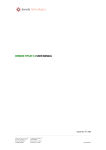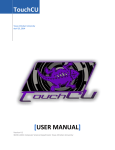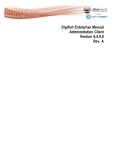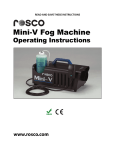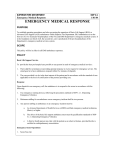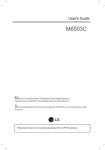Download Radio Frequency Interference (RFI) is electromagnetic radiation
Transcript
1 2 William Wheeler , Ph.D., and David LaFleur , B.A, J.D. © 2006, All Rights Reserved Radio Frequency Interference (RFI) is electromagnetic radiation which is emitted by electrical circuits as a by-product of their normal operation, and which causes unwanted signals and interference to be induced in other circuits.3 RFI interrupts, obstructs, or otherwise degrades or limits the effective performance of those other circuits. The Federal Communications Commission (FCC) regulates equipment that emits RFI and requires that all “covered” equipment (including check scanners, PC’s, and other computer peripherals) be FCC certified before they are marketed within the US. RFI White Paper Page - 1 of 12 Executive Summary Why should Banks be concerned with the FCC4 Class Rating (A or B) of the check scanners being deployed for image capture at the Branch and Remote Deposit Capture at their corporate clients? FCC Class refers to the standard attained in limiting the emission of Radio Frequency Interference (RFI). FCC Class A compliance reflects meeting the minimum legal requirement for RFI emissions with its standard tolerating radiated and conducted RFI emissions of significantly greater level. FCC Class B compliance is a more demanding standard that confirms the device emits RFI below demanding Class B limits. The non-technical reader may think of RFI as like the electromagnetic equivalent of tobacco smoke polluting a crowded room. If we metaphorically view the RFI from a Class B device as smoke exhaled from a single person smoking a filtered cigarette, RFI from a Class A device is like the smoke in a crowded room with everyone smoking Camels. The RFI from a Class A device can be so disruptive that the FCC bans Class A device marketing for residential or hospital use. As unwanted tobacco smoke impairs second hand inhalers, RFI can interfere with video surveillance systems, degrade the appearance of computer monitors, decrease the reliability of proximal electronic systems and computer networks, and degrade the accuracy and integrity of computer data. Unpredictable operational risk, exposure to potential liability, and unanticipated remediation costs may all lie ahead by deploying minimally compliant Class A devices instead of Class B devices. 5 Current research reveals that only a few scanner models are compliant with the demanding FCC Class B standards while most appear to be engineered only to the lax Class A standard. In 2006, this is an unexpected and very troubling discovery. Banks and their corporate customers that have deployed check scanners should determine the FCC rating class of their devices. Upon discovery of a Class A rating, they should carefully screen installations for adverse RFI effects. Beyond distortion of video signals (in CRT displays and security cameras), the most common symptom is simply unreliable computing, often blamed on bugs in new software. Banks that are providing or specifying Class A compliant scanners for Remote Deposit Corporate Clients should evaluate potential liability for RFI issues that might be introduced to their customers. Check capture is a core competence for banks and their customers come to rely on their expertise in this area. Where adverse RFI effects can be demonstrated, mitigation of these effects is usually possible but costly requiring shielding, installation of special filters on possibly affected devices, and changes to site electrical wiring. For most, these costs will be unanticipated. In many instances, simply replacing Class A units with Class B units is the safest approach and will prove more cost effective. Those currently acquiring or about to acquire small check scanners should make FCC Class B compliance a requirement. We suggest that above summarizes an important issue requiring bank evaluation and action. Additional information regarding this complex issue is provided in the FAQ format below. RFI White Paper Page - 2 of 12 Frequently Asked Questions We have framed this report in a FAQ format to speak clearly to the specific concerns of different readers so that you might quickly scan the questions for those most aligned with your business and interests. Since the answer to each question stands on its own, the reader of all FAQs may find some redundancy. Our answers are intended to advise and inform and are not at the level required to satisfy the needs of an electrical engineer. However, we have tried to avoid the kind of over simplification that distorts the essence of a complex technical topic. What has the Federal Communications Commission (FCC) got to do with regulating check scanning equipment used in the bank? The FCC sets requirements for all electronic equipment categories that have been shown to generate high frequency electrical or radio signals that can unintentionally interfere with the operation of the communications systems (radio, television, telephone, etc.) normally associated with the FCC. These unwanted signals are referred to as RFI, for Radio Frequency Interference. Like most PC’s, PC peripherals and other devices including digital electronics, check scanners are RFI generators that fall under FCC purview for regulation. Any check scanner that has been delivered to your bank in accordance with US Federal Law will in principle have followed FCC procedural mandates and met the technical requirements for qualifying as either a Class A or a Class B device. If you know how to interpret the information, FCC Class is usually evident from product labeling, though in some cases user documentation must be consulted. Meeting FCC requirements at one of the two levels is not an option; it is a requirement for marketing within the US. For some regulated products like PC’s, there is no choice but to meet the more demanding Class B standards. What is the difference between a Class A and a Class B rating? Class A standards are technically lenient in allowing significant emission of radiated and conducted RFI. A Class A rating is associated with a marketing restriction to business use in a business environment. In its public enforcement role, the FCC may order the user of a Class A device to cease using it if it is causing interference irrespective of whether the RFI it generates remains within Class A specified limits. Class B standards require significantly less RFI levels than Class A, and have maintained standards of procedural rigor. A Class B rating is associated with unrestricted marketing for business and residential use. As an RFI standard, it reflects an emission level that the FCC recognizes as unlikely to cause consequential interference. While a complaint seldom leads to an enforcement action against the user of a Class B device, the enforcement issue is whether or not Class B limits are being exceeded. If they are, the device is likely broken or otherwise defective. We are concerned directly with risk/cost consequences of the RFI level commonly associated with a Class A versus Class B device. Under the right circumstances, RFI levels from a Class A device are high enough to be internally disruptive whereas, generally, RFI levels from a Class B device are low enough to be benign. The implicit assumption is that a business has the internal wherewithal to remediate and adjust to accommodate a moderately RFI-hostile environment, whereas the public in its own home does not. A business that is for unrelated reasons using Class A devices should be aware of RFI concerns, anticipate the occurrence of problems caused by Class A RFI levels, make appropriate installation provision (e.g., separate electrical circuits, properly shielded cables, paying attention to device placement, etc.) and remain aware that further remediation may be necessary. The FCC strongly encourages RFI White Paper Page - 3 of 12 manufacturers of equipment sold exclusively for use in a business environment to qualify it for the more demanding Class B norms. How Do I Tell if a Check Scanner Is Class A or Class B? If you already own or otherwise have access to the device in question, this question can be answered by a knowing examination of product labeling and / or the product user’s manual where an “FCC Notice” typically appears at or very near the beginning (where its presence is a legal requirement). The information in Table 1 (found at the end) will help you interpret what you see in the labeling. Based on vendor claims of market share, at the time of writing the odds are very high you will discover that the scanners deployed at your bank are Class A. If you do not yet own the product, this may be harder to discover than one would think because, either by oversight or intent, the information is simply not easily found in the marketing materials for most vendors. We therefore suggest that you: Ask your potential suppliers for complete written product specifications. Check the unit’s product labeling if you are involved in a demonstration of the unit. Note that a product that is in compliance will be properly labeled in a manner that allows you to infer FCC Class. Request a copy of the users / operators manual and check for the legal statement. Note that a product that is in compliance will include a statement that allows you to infer FCC Class. Look for any requirement that states language like ‘The scanner should be plugged into a dedicated outlet’. This is a good indication that the unit is probably Class A certified and should be cause for asking questions of the vendor and exploring RFI problems as a topic with vendor supplied reference accounts. As a buyer, you should simply demand a clear and unambiguous answer to the question. In the presence of either ambiguity or doubt, we think it reasonable to request the vendor supply a copy of the test report showing FCC results from the FCC approved test laboratory. The report will clearly indicate test results (pass or fail) and whether the test standards applied are for Class A or Class B. A similar report, but in response to CE European RFI emission (and resistance) requirements does NOT meet US requirements, even though European and American standards are quite similar and Europe in the CE standards makes a similar distinction between a Class A and Class B device. Are there any reasons why RFI and Class A scanners are a particular concern at a bank branch? There are a number of reasons why RFI might be a bigger concern at a bank branch than at other business settings. 1. The number of scanners (one per Teller Station) being installed in a small area and in close proximity to other equipment is a “red flag”. This multiplies the likelihood that ill effects of RFI will adversely impact operation of a proximal system. If we think of RFI as cigarette smoke and target systems as second hand inhalers, we have lots of smokers and lots of non-smokers in a small room. 2. A surveillance camera system is an integral part of every branch’s operation and further one where the video is intended to prove very important to an investigation. Video signals are particularly sensitive to degradation from RFI. In our metaphor, the surveillance cameras are like asthmatics in a room filled with smokers. RFI White Paper Page - 4 of 12 3. RFI disruption of surveillance camera signals can usually be mitigated by the installation of special line filters and electrical shielding. Indeed, the existence of suppliers providing such gear (for RFI mitigation) is a testament to the impact of RFI on these systems and equipment. However, remediation of an RFI problem is expensive. And, in our metaphor, rather than simply putting up a non-smoking sign, it is conceptually akin to addressing our second hand smoke problem by buying gas masks for the non-smokers. 4. The trend in bank branches is more numerous, smaller, and often in multi-tenant settings (e.g. grocery store branches). In other words, the footprint of a lot of branches is starting to look like than found in an apartment building, exactly the kind of situation where the FCC has mandated Class B compliance for decades. Introducing unwanted and unsuspected RFI into such a setting does not make for happy neighbors. The concern is even higher for a branch at street level in an urban setting where residences may be located above. 5. And, of course, image enabling the branch probably increases data traffic on the branch network by a quantum leap, thus creating more opportunity for RFI disruption of computing processes and data capture to occur. What do these five concerns mean to the bank? The impact is primarily in three areas: Increased Operational Risk Recent and pending regulatory changes have required banks to assess their operational risks and mitigate their risk exposure. RFI impacts on video security and accuracy of data capture unnecessarily increase operational risk. Using our smoking analogy, this is akin to continued smoking against doctor’s orders and the surgeon general’s advice, thus unnecessarily increasing risk of adverse impacts and effects. Exposure to potential liability This is a double edge sword. Banks can be held accountable for consequential damages to their corporate customers for recommending or mandating the use of inferior Class A equipment. A growing number of corporate businesses will have deployed or started implementation of remote 6 capture this year. Banks are held to a higher standard because check and payment capture is a core competence. Unanticipated Remediation Costs Special grounded shielding, filters, and scanner-dedicated circuits represent a few of the expense items that may be required to remediate a branch environment to protect against unwanted RFI dangers due to Class A equipment. There is no good rule of thumb to estimate these costs or the attendant labor and business disruption they bring. Is RFI a new problem and why are image check scanners a concern? No. It is an old problem that has been resurrected. Image check scanners are a particular concern for two reasons: 1. Clock signals used in scanner imaging electronics (< 30 MHZ range) are in the frequency range that was particularly problematic 15 or so years ago and that naturally shifted well above this range as PC’s got faster. RFI White Paper Page - 5 of 12 2. The Class A level of FCC compliance for some products is not only unexpected in this day and age in devices that function in most instances as peripherals to a PC, it is indicative of an RFI level known to be problematic in the past. Are you being alarmist? For any specific circumstance, the answer is possibly yes. Here is our dilemma: . 1. If we think of a system affected adversely by RFI as like our metaphorical non-smokers in a room with a smoker, individual systems vary greatly in susceptibility to RFI disruption just as individual non-smokers vary in their reaction to smoke. We, of course, have absolutely no idea regarding the RFI vulnerability of systems in a particular branch, let alone the systems and architecture that might most typify branches for a particular bank. 2. The same equipment installed in two different locations can yield different results because the effects of RFI are greatly influenced by such issues as relative proximity of devices, materials that may make up barriers between devices, electrical wiring in the facility and what is plugged in where, etc. Conversely, problems are likely to result where these factors adversely combine. Absent other information, whether such a combination has resulted at any particular location in adverse consequences is only a guess. However, if we continue our smoking metaphor, it is definitely the case that some heavy smokers live to ripe old ages. And it is also true, that some people who have never smoked die of lung cancer each year. This general set of facts hardly negates the general health wisdom of choosing clean over polluted air. How do I determine if I have problems caused by RFI? 1. Survey whether or not you are experiencing “symptoms” at your branches. The three most common signs of RFI disruption are: Poor quality images/interference patterns in your surveillance camera system. Any sign of image degradation on your CRTs. Unexplained unreliability in your branch network or branch operating software processes. Note that these symptoms could have an underlying cause other than RFI (from check scanners). But if you are not experiencing one or more of these symptoms, the current level of RFI is likely not a problem. 2. If you are experiencing symptoms (and noting that unreliable networks and software are a can of worms), you are often able to clarify matters by first powering off all systems except the one displaying symptoms (e.g., the surveillance system). If surveillance images improve, RFI from one or more electronic devices in your branch is the likely cause. Turn these other devices on one at a time. If you are fortunate, the source will be revealed and the problem might be curable by one of the following: Moving the device to a new location Plugging the device into a different (preferably isolated) electrical circuit. Relocating cable routes. 3. If your “symptoms” are exclusively in the area of degraded surveillance video, your surveillance system vendor can usually improve upon the problems at a price by taking steps that “harden” the surveillance system and filter out interference. RFI White Paper Page - 6 of 12 4. Expert RFI consultants are available that can exactly characterize the problem and recommend solutions that may include adding grounded shielding and expanding AC distribution capability. 5. The question that should be asked before more than trivial efforts at remediation is whether or not it is more cost effective to act upon the device creating the interference. What is the History of the two FCC Classes? The traditional regulatory purview of the FCC was broadcast communications and communications equipment. However the electronics revolution of the 1960’s spawned many products that emitted disruptively high levels of RFI as an unintentional byproduct of their operation. Because, among other things, RFI generated by these new products interfered with broadcast communications, FCC regulatory authority was extended to all products that emitted RFI. In response to business objection regarding the (then) high cost of meeting the demanding RFI emission standards that were initially proposed, the FCC set rigorous standards for all products sold to and used in residences (Class B) and much laxer standards for business market-restricted products (Class A). Note that the market restriction on Class A rated equipment is akin to laws restricting cigarette sales to adults. Viewed in this manner, and recognizing that the FCC may order the user of a Class A device to shut it down at any time, the Class A label mirrors the Surgeon General’s warning. It is notice that RFI levels sufficient to merit remedial attention may be anticipated. Within a few years of Class B standards being enforced for “consumer” products, consumer awareness that one electronic device might interfere with another began to wane. Then personal computers that were only certified to the Class A level began showing up widely in homes and serious RFI interference once again became a widespread problem. This was the late 1980s. The FCC was forced to act and 7 mandated that any PC that was marketed in the US had to meet Class B requirements . This requirement became effective in 1992. Today, virtually all “peripherals” that interface to PC’s are Class B compliant. This has been true for virtually all such peripherals since at least the mid 1990’s. Let us be perfectly clear about this. We thought PC peripherals with an FCC Class A rating went extinct in the mid 1990’s. Discovering small check scanners with an FCC Class A rating on the market in 2006 is like discovering a dinosaur living in Central Park. An inference of the history is that if your bank branches are not yet check image-enabled, it is very likely that all or almost all equipment currently in the branch has a Class B rating. Why? For no other reason than virtually all business horizontal-market use and PC-peripheral equipment introduced in the last 10 years is Class B rated. The engineering practices required for a Class B rating attainment have simply become the norm and there is no longer any obvious cost advantage associated with designing to a lesser standard. Introduction of Class A check scanners, especially in a quantity of one unit per Teller Station, is very likely to challenge a previously pristine RFI environment with hostile levels of RFI. Class A remains an expectation today in the factory, the machine shop, and the operations center --- places where equipment is sized on an industrial scale. You simply no longer find much equipment appropriate to “Business Use Only” in an office. While there have been many improvements in hardware and software since the early 1990’s, we believe that the progressively less hostile RFI environment has been a significant factor in computer and network reliability. RFI White Paper Page - 7 of 12 Why are you surprised at discovering that several existing products are Class A? Although clarifying details may be found in the answers to several other questions, there are basically two reasons: 1. We fail to see either justifiable cost or any performance advantage associated with a Class A design implementation and distinct reliability advantages lying in following the design practices required for Class B rating attainment. 2. While the sale and purchase of Class A devices “for business use only” is perfectly legal, the consequence of RFI at Class A levels is well known and real. That is why the market for Class A devices is restricted by regulation and why that regulation provides for: a) b) Business internal responsibility for remediation of any internally created RFI problems. Business external responsibility for RFI from a Class A device that causes interference at a neighboring property. The FCC can simply order that Class A compliant, but offending, equipment be turned off. In this day and age, and given a choice and awareness, we can not imagine a bank increasing operational risk unnecessarily without a compensating reward. I read in the literature for a particular check scanner that it meets FCC Part 15 Requirements. Does that mean that his scanner is FCC Class B compliant? The short answer is probably not because this language is part of FCC mandated labeling language for a Class A device (See Table 1), but possibly so. You must dig deeper for a clear answer. Part 15 of the FCC rules is a proper reference to the chapter of the FCC rules that regulate, among other things, virtually all computer and electronic equipment. Within Part 15, the requirements for both a Class A and a Class B rating are clearly defined, along with testing methods. The words you note could thus be equally correct for a Class B compliant or a Class A compliant scanner. If a scanner meets the far more demanding Class B requirements, this is not something one would think a vendor wants to keep hidden though we could well imagine that a vendor might want to blur reality if his product was only Class A. So we would expect that a deeper examination will show that the scanner meets the minimum requirements for Class A. This has also proved to be the case where we have delved into to the use of similarly vague language like “FCC” listed among other references in specifications. I read in the literature for a particular check scanner that it meets CE Requirements. Does this mean it meets FCC regulations as well? The short answer is NO. CE is a set of standards that must be met for product marketing in Europe. FCC is a Federal legal requirement that must be met before a product is marketed in the US. CE does set RFI standards at a Class A and Class B level that are in fact very similar to US standards. While it is the case that a CE marked product will likely meet the similar class (A or B) standard when tested to US rules, US testing conditions are different and a CE test can not be used as a basis for claiming FCC compliance as either a Class A or Class B device. So there is absolutely no ambiguity. Having met CE requirements is absolutely not the same as FCC and does not stand in place of FCC. RFI White Paper Page - 8 of 12 But there is an added point of confusion, particularly to Europeans. It is that CE is a “self-certification process” that does not require passing results on file from an appropriately credentialed third-party testing laboratory until one year after a new product is first introduced to market. For that first year, a lesser standard of internal testing in conjunction with engineering practices consistent with standard attainment is good enough. Thus, the European naturally assumes with confidence that a product will pass will be good enough for a year in the US as well. US law requires full FCC compliance before production delivery begins. If it is RFI that is causing the fuzzy lines on my monitor, how does it get there? There are two ways RFI can reach an electronic device where it causes problems. First, there is through the air as a broadcast signal just like radio or television signals. Signal and electrical cables make unintentional antenna that gather the RFI, transforming it into voltage fluctuations within the affected device that, in turn, interfere with normal device electronic function causing, for example, shifting line patterns you might be seeing on your computer monitor. RFI received through the air is called radiated RFI. Second, an electronic device can cause RFI to be conducted out through its power source cable to affect other devices that gain their power from the same electrical circuit. RFI propagated through the electrical circuitry is called conducted RFI. If a Class A certified device is negatively affecting the operation or other equipment because of broadcast RFI, the affected equipment is usually pretty close. But deleterious RFI can influence equipment on the same electrical circuit at considerable distance. How do the technical standards for a Class A versus Class B rating differ8? The chart graphs FCC limits on conducted RFI for Class A versus Class B. As may be noted, above the 1.6 MHz range, Class A is more lenient by roughly 22 dB – an approximate order of magnitude difference. Conducted RFI is RFI that is conducted back from the offending device through its AC power input source to potentially affect the operation of other devices which receive their power from a common electrical feed. Circuit breakers are designed to function as a filter suppressing at least a portion of any conducted RFI that may reach them. Thus, the manufacturer of a Class A device often may specify that the device they sell be “given its own electrical circuit” for reasons that have nothing to do with the current draw. RFI White Paper Page - 9 of 12 FCC radiated RFI limits are very similar for Class A and Class B with one big exception – Class B limits are measured with an antenna located 3 meters, Class A limits are measured with an antenna at 10 meters. The chart below approximates what this means in terms of relative radiated RFI strength at the indicated distances (feet) from a single Class A versus Class B radiator located at the left edge of the chart. Relative Radiated RFI Magnitude (1 = Class B Allowable limit @ 3 Meters) 10000 RFI from FCC Class-A Compliant Scanner Surve illance Cam e ra RFI from FCC Class-B Compliant Scanner 1000 100 Surve illance Cam e ra 10 Clas s-B Standard Scanner Here 1 1 2 3 4 5 6 7 8 9 10 Teller Station Electronics (incuding other scanners) & Network Cabling Behind and Under Counter 0.1 Distance in Feet from Scanner Note that the scale is logarithmic, reflecting roughly a 10 fold difference at all distances. As you can see, a “victim” device that was adversely affected by radiated RFI from a Class B device sitting absolutely next to it could be similarly affected by a Class A device 3 to 4 feet away. Those that might want to explore the details of FCC standards should consult the latest revision of 47 CFR, Part 15. This is web accessible via http://www.fcc.gov. RFI White Paper Page - 10 of 12 Appendix Table 1. Identifying Product FCC Class from Product Labeling and User Documentation User’s Manual Statement Identifies Class A Identifies Class B This equipment has been tested and found to comply with the limits for a Class A digital device, pursuant to Part 15 of the FCC Rules. These limits are designed to provide reasonable protection against harmful interference when the equipment is operated in a commercial environment. This equipment generates, uses, and can radiate radio frequency energy and, if not installed, and used in accordance with the instruction manual, may cause harmful interference to radio communications. Operation of this equipment in a residential area is likely to cause harmful interference in which case the user will be required to correct the interference at his own expense. This equipment has been tested and found to comply with the limits for a Class B digital device, pursuant to Part 15 of the FCC Rules. These limits are designed to provide reasonable protection against harmful interference in a residential installation. This equipment generates, uses and can radiate radio frequency energy and, if not installed and used in accordance with the instructions, may cause harmful interference to radio communications. However, there is no guarantee that interference will not occur in a particular installation. If this equipment does cause harmful interference to radio or television reception, which can be determined by turning the equipment off and on, the user is encouraged to try to correct the interference by one or more of the following measures: -- Reorient or relocate the receiving antenna. -- Increase the separation between the equipment and receiver. -- Connect the equipment into an outlet on a circuit different from that to which the receiver is connected. -- Consult the dealer or an experienced radio/TV technician for help. FCC Logo Present Only on Class B Devices Product Label Current Products Possible Product Label Older Products RFI White Paper Page - 11 of 12 “For Office Use Only” “For Business Use Only” “Class A” “For Home and Office Use” “Class B” Notes, Credits and Contact Information 1 William (Bill) Wheeler may be contacted at [email protected] David LaFleur may be contacted at [email protected] 3 Wikipedia: http://en.wikipedia.org/wiki/Radio_frequency_interference 4 Extensive information germane to RFI, the FCC, and its regulations can be found at http://fcc.gov. Applicable regulations can be found within 47 CFR Part 2 and 47 CFR Part 15. 5 We have chosen not to identify the FCC Class associated with any particular check scanner because it is subject to change. While we believe that a Class B rating is suggestive of product engineering more reflective of current electronic design practices that favorably contribute to product reliability, this RFI issue stands alone from other comparative strengths and weaknesses of competing products. 6 Treasury and Risk Management, September 2005 7 Strictly speaking, this is not exactly true. A PC manufacturer may petition the FCC for special exception given a combination of specialized application, sound technical reason, and special marketing provisions to insure delivery only to a Class A environment. Such applications are evidently extremely rare and more rarely granted. 8 FCC conducted RFI limits chart from Tyco Electronics, “Corcom Product Guide.” Tyco Electronics is a leading provider of electronic components designed to mitigate conducted RFI from digital electronic circuits. The radiated RFI comparison chart is calculated as a relative approximation by the authors given the simplifying assumption that RFI amplitude diminishes in accord with the square of relative distance. Reflective, absorptive and shadowing RFI interactions with objects in any particular environment, especially when combined with a directional RFI source, mean this chart should not be expected to conform to any particular set of real-world measurements. The photo background to this chart was retrieved with a Google image search using “bank counter” as key words. No clear attribution was present when the image was retrieved and the link was inoperable when the matter was revisited a few days later. Since we have not found another graphic that allows us to so clearly illustrate the relationship between a bank-counter and distance in approximately accurate scale, we have used the image without proper attribution. We would like to rectify this issue and would appreciate a note from any reader that can clarify the image source. 2 RFI White Paper Page - 12 of 12












